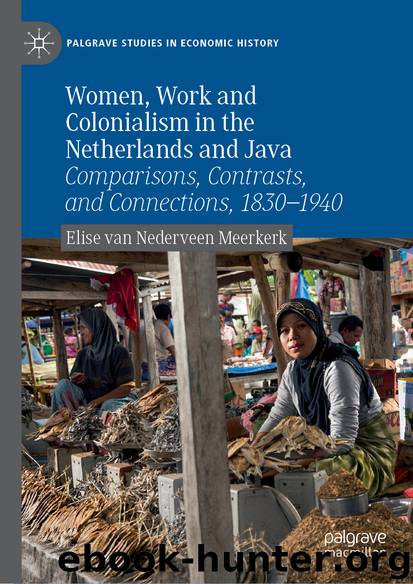Women, Work and Colonialism in the Netherlands and Java by Elise van Nederveen Meerkerk

Author:Elise van Nederveen Meerkerk
Language: eng
Format: epub
ISBN: 9783030105280
Publisher: Springer International Publishing
4.2 Economic Policies, Industrialisation and De-industrialisation in the Dutch Empire
As noted in earlier chapters, the Netherlands was a relatively late industrialiser. Before the southern provinces (present-day Belgium) seceded from the Kingdom of the Netherlands in 1830, industry—mainly mining and textiles—had been concentrated in the south. Indeed, before this secession, Dutch textile imports into Java came predominantly from the Southern Netherlands. In 1824, King Willem I established the Dutch Trading Company (Nederlandsche Handel-Maatschappij—NHM ). Formally, the NHM was a private company, in which the king himself took 4000 shares by investing four million guilders. 3 Its broad aim, however, was to enhance Dutch economic interests by promoting industry and reviving international trade. Willem I envisaged the new company as being a successor to the VOC, which had gone bankrupt at the end of the eighteenth century (de Graaf 2012, 39–41). Although it never obtained a full monopoly, the NHM was required to give trading preference to Dutch goods and to use only ships sailing under the Dutch flag; it was also given the exclusive right to handle all government shipping to and from the colonies (van Zanden and van Riel 2004, 112).
Apart from the transportation of cash crops such as coffee and sugar coming from Java to the Netherlands, NHM ships were given priority in carrying textiles from the metropole to the colony. Johannes van den Bosch, Governor General of the Dutch East Indies and inventor of the Cultivation System (see Chapter 3), single-handedly convinced the king that this would provide the opportunity to promote industrialisation in the Northern Netherlands (Mansvelt 1925a, 264–265). The large population of Java, which would be primarily engaged in cash crop production instead of local industry, formed an excellent potential market for this. Consequently, the preferential trading rights awarded to the NHM were reinforced by the introduction of tariffs of twenty-five to thirty-five per cent for non-Dutch textile imports to the East Indies, whereas the Dutch paid just six per cent in import tax (Van der Eng 2013, 1025–1026). 4
Simultaneously, numerous measures were taken in the metropole to enhance textile production. After the Belgian secession, these initiatives were redirected towards the northern provinces. For example, Belgian cotton textile producers were encouraged to transfer their businesses to the Northern Netherlands (Jansen 1999, 139). The NHM invited engineers and investors from Belgium and Britain to the Netherlands, particularly to the eastern region of Twente, where there was a tradition of linen weaving and wages were low, in order to create a local cotton industry. In 1833, a weaving school was established in Twente to instruct cottage weavers in the region how to work with the flying shuttle. In addition, there were attempts to concentrate weavers in workshops, although it would take several decades before cottage weaving was entirely abandoned (van Nederveen Meerkerk et al. 2010, 379).
To promote these organisational and technical innovations, the Dutch government subsidised the initiation of cotton textile production all over the Northern Netherlands, although the emphasis was placed on the region of Twente (van Zanden and van Riel 2004, 118).
Download
This site does not store any files on its server. We only index and link to content provided by other sites. Please contact the content providers to delete copyright contents if any and email us, we'll remove relevant links or contents immediately.
Pale Blue Dot by Carl Sagan(4613)
The Rules Do Not Apply by Ariel Levy(4523)
Goodbye Paradise(3446)
Ogilvy on Advertising by David Ogilvy(3327)
Delivering Happiness by Tony Hsieh(3283)
Liar's Poker by Michael Lewis(3222)
Into Thin Air by Jon Krakauer(3130)
Purple Cow by Seth Godin(3069)
Rogue Trader by Leeson Nick(2824)
The Social Psychology of Inequality by Unknown(2763)
The Airbnb Story by Leigh Gallagher(2700)
4 - Harry Potter and the Goblet of Fire by J.K. Rowling(2530)
The Mind Map Book by Tony Buzan(2415)
Bossypants by Tina Fey(2373)
All the President's Men by Carl Bernstein & Bob Woodward(2261)
Claridge's: The Cookbook by Nail Martyn & Erickson Meredith(2257)
Six Billion Shoppers by Porter Erisman(2226)
Master of the Game by Sidney Sheldon(2182)
Alibaba by Duncan Clark(1979)
